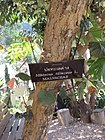Note: This is a project under development. The articles on this wiki are just being initiated and broadly incomplete. You can Help creating new pages.
Talipariti tiliaceum
Beach hibiscus is an evergreen shrub or small tree with low, spreading branches, growing 3 - 10 metres tall. A true multi-purpose tree, it is considered to be one of the most useful trees in the Pacific region. It is commonly gathered from the wild for food, medicine, fibre and timber, is sometimes cultivated and often protected when other trees are cleared from an area. The tree is often cultivated as an ornamental plant and hedge in tropical areas.
Contents
- 1 Uses
- 2 Parts Used
- 3 Chemical Composition
- 4 Common names
- 5 Properties
- 6 Habit
- 7 Identification
- 8 List of Ayurvedic medicine in which the herb is used
- 9 Where to get the saplings
- 10 Mode of Propagation
- 11 How to plant/cultivate
- 12 Commonly seen growing in areas
- 13 Photo Gallery
- 14 References
- 15 External Links
Uses
Coughs, Sore throats, Sores, Cuts, Open wounds, Boils, Swellings, Skin diseases, Tuberculosis, Stomach-aches, Gonorrhoea.[1]
Parts Used
Chemical Composition
Analytical grade ethanol (Merck), analytical grade acetic acid (Merck), analytical grade n-butanol (Merck) and analytical grade methanol (Merck) were used in the analysis work.[2]
Common names
| Language | Common name |
|---|---|
| Kannada | ಬಿಳಿಪಟ್ಟ Bilipatta, ಕಾರ್ಕ್ ಬೆಂಡು Kaark bendu |
| Hindi | Bola, Chelwa |
| Malayalam | Thaipparutti |
| Tamil | Nir-p-parutti |
| Telugu | Cherigogu |
| Marathi | Belpata |
| Gujarathi | |
| Punjabi | |
| Kashmiri | |
| Sanskrit | Bala |
| English | Beach hibiscus, Coastal cottonwood |
Properties
Reference: Dravya - Substance, Rasa - Taste, Guna - Qualities, Veerya - Potency, Vipaka - Post-digesion effect, Karma - Pharmacological activity, Prabhava - Therepeutics.
Dravya
Rasa
Guna
Veerya
Vipaka
Karma
Prabhava
Habit
Identification
Leaf
| Kind | Shape | Feature |
|---|---|---|
Flower
| Type | Size | Color and composition | Stamen | More information |
|---|---|---|---|---|
| {{{5}}} |
Fruit
| Type | Size | Mass | Appearance | Seeds | More information |
|---|---|---|---|---|---|
Other features
List of Ayurvedic medicine in which the herb is used
Where to get the saplings
Mode of Propagation
Seeds, Cuttings of half-ripe wood.
How to plant/cultivate
Beach hibiscus is a tropical plant that is usually found in coastal and low elevation habitats, but can be found at elevations up to 800 metres. It prefers a mean annual rainfall of 900 to 2,500mm with a mean maximum temperature 24 - 41°c and a mean minimum temperature of 5 - 24°c.[5]
Commonly seen growing in areas
Found throughout the tropics, Often on beaches, Saline swamps, [[:Category:Herbs that are commonly seen in the region of |]], Impenetrable thickets.
Photo Gallery
References
- ↑ Indian Medicinal Plants by C.P.Khare
- ↑ Chemical constituents
- ↑ Common names
- ↑ [Morphology]
- ↑ Cultivation
External Links
- Ayurvedic Herbs known to be helpful to treat Coughs
- Ayurvedic Herbs known to be helpful to treat Sore throats
- Ayurvedic Herbs known to be helpful to treat Sores
- Ayurvedic Herbs known to be helpful to treat Cuts
- Ayurvedic Herbs known to be helpful to treat Open wounds
- Ayurvedic Herbs known to be helpful to treat Boils
- Ayurvedic Herbs known to be helpful to treat Swellings
- Ayurvedic Herbs known to be helpful to treat Skin diseases
- Ayurvedic Herbs known to be helpful to treat Tuberculosis
- Ayurvedic Herbs known to be helpful to treat Stomach-aches
- Ayurvedic Herbs known to be helpful to treat Gonorrhoea
- Herbs with Flowers used in medicine
- Herbs with Leaves used in medicine
- Herbs with Green bark used in medicine
- Herbs with common name in Kannada
- Herbs with common name in Hindi
- Herbs with common name in Malayalam
- Herbs with common name in Tamil
- Herbs with common name in Telugu
- Herbs with common name in Marathi
- Herbs with common name in Sanskrit
- Herbs with common name in English
- Habit - Evergreen tree
- Index of Plants which can be propagated by Seeds
- Index of Plants which can be propagated by Cuttings of half-ripe wood
- Herbs that are commonly seen in the region of Found throughout the tropics
- Herbs that are commonly seen in the region of Often on beaches
- Herbs that are commonly seen in the region of Saline swamps
- Herbs that are commonly seen in the region of
- Herbs that are commonly seen in the region of Impenetrable thickets
- Herbs



